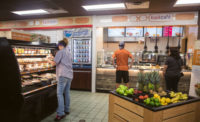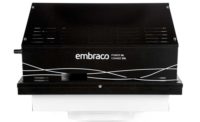
Glumac’s office incorporates wireless technology in the open areas and wired technology in the private offices. (Courtesy of Ryan Gobuty, Gensler)
IRVINE, Calif. - Glumac considers itself to be a forward-thinking mechanical, electrical, and plumbing (MEP) engineering firm that is a leader in sustainable design. As such, when the time came for the firm to move its office to a downtown high-rise, it was decided that Glumac would use its new space as a showroom of sorts that would highlight the intelligent, innovative - and often invisible - MEP technologies that can be incorporated into a sustainable design.
These technologies include state-of-the-art lighting, electrical, and HVAC controls, as well as occupancy sensors and daylight harvesting controls that are powered by ambient light, vibrations, and fluctuations in local temperature and pressure in the space. Many of the sensors and controls utilized in the new office space are wireless and require no batteries.
In seeking a LEED® Platinum certification, the Glumac Irvine office also became the country’s first completed “Office of the Future” pilot project under the new North American Office of the Future (OTF) Consortium. OTF is a new multi-utility energy efficiency pilot program for commercial office spaces. Developed by the Office of the Future Consortium, the OTF program provides support for high performance, technical approaches to lighting, lighting controls, plug load controls, HVAC performance, and metering in tenant improvement projects. The program is managed by New Buildings Institute in conjunction with several national utilities.
EVERYTHING ON THE TABLE
In mid-2009, Glumac decided it was time to move its office from the suburbs to a downtown location. After considering several stand-alone buildings, the firm found the 8,672-sqare-foot space it desired in the Irvine Towers, an existing office complex that consists of five high-rise buildings. Glumac’s office space is located on the ground floor of one of those high-rises and features open spaces and large concrete columns that reach up to the 21-foot ceiling.The engineers at Glumac designed the MEP systems for its new space by focusing on innovative technologies that would increase energy efficiency as well as employee comfort. “We threw everything out on the table during the design process,” said Brian Berg, P.E., CEM, associate mechanical engineer, LEED® AP, Glumac. “We would think of a new idea, and then it would morph into something else. We didn’t really start with a plan - we just included whatever we thought would work well.”
Moving into an existing space meant that Glumac engineers had little control over the existing HVAC system, which consists of a central plant that serves all five buildings in the office complex. Air handlers serve each floor with double duct VAV boxes. To save energy, carbon dioxide sensors were installed throughout Glumac’s office to modulate the VAV boxes depending on occupancy. Boxes are also modulated using wireless lighting occupancy sensors and temperature sensors.

The
engineers at Glumac designed the MEP systems for its new space by focusing on
innovative technologies that would increase energy efficiency as well as
employee comfort. (Courtesy of Ryan Gobuty, Gensler)
A unique feature of the wireless lighting and HVAC controls used in the open spaces at Glumac is the fact that they do not require batteries; instead, they operate on solar power. A small solar panel is integrated into each wireless sensor, which collects light during the day and night, including ambient light.
“We have a centrally located antenna receiver in the office that receives all of the wireless HVAC and lighting controls using the EnOcean communication protocol. This runs through an EnOcean-to-BACnet gateway and is tied into our local energy management system, which consists of the BACnet backbone and Niagara Tridium technology. All controls in our private offices are traditional wired controls,” noted Berg.
Glumac wanted to use its new office as a demonstration space, which is why it was decided to incorporate wireless and wired technology. It made sense to use the wireless technology in the open areas, as conduit running down the columns or up the window moldings would not have been aesthetically pleasing. Wired technology is better suited for private offices, which usually have walls and ceilings that can better hide conduit.

A
stylish table made from bamboo - considered to be a renewable resource - was
purchased for Glumac’s new employee breakroom. (Courtesy of Ryan Gobuty,
Gensler)
LIGHTS OFF WHEN NOBODY'S HOME
All the lighting in the office is mounted to the furniture, while recessed LED lights are utilized above the few workstations with a ceiling and for all of the under-cabinet lights in the space. Lighting fixtures throughout the office are controlled by occupancy sensors with most lights also controlled with daylight harvesting controls to dim the lights when outdoor ambient light is sufficient for illumination. Information received from the occupancy and daylight devices is sent wirelessly to receivers located at the workstations to control the furniture-mounted lighting.The lighting power and receptacle power usage are each being submetered separately to determine actual power consumption in the space. These meters make it possible to monitor the daylight harvesting system, as well as the power usage of the office equipment. This enables Glumac to troubleshoot potential lighting control problems and create a historical log of the performance of the lighting and HVAC control systems.

All
the lighting in the office is mounted to the furniture, while recessed LED
lights are utilized above the few workstations with a ceiling and for all of
the under-cabinet lights in the space. (Courtesy of RMA Photography and The
Lighting Quotient)
As can be imagined, interoperability became an issue during this project, as the lighting, HVAC, and metering systems each utilize a different protocol. “This was another demonstration portion of our space because we wanted to see if we could tie together Modbus, EnOcean, BACnet, and the energy management system used by the central plant with our local DDC system,” said Berg. “There was definitely a learning curve involved with this, but it ended up working just fine.”
In addition to state-of-the-art controls, Glumac made use of other sustainable design features, such as low flow plumbing fixtures and millwork made from bamboo plywood and rapidly renewable wheatboard. There was also an effort made to provide passive solar heating, natural lighting, and views to the outdoors for all occupants.
Berg noted that they are shooting for LEED Platinum certification, but even more importantly, everyone is happy in their new space. “I have not heard one complaint since we moved in 8 months ago. It has been incredible.”
Publication date:12/13/2010




